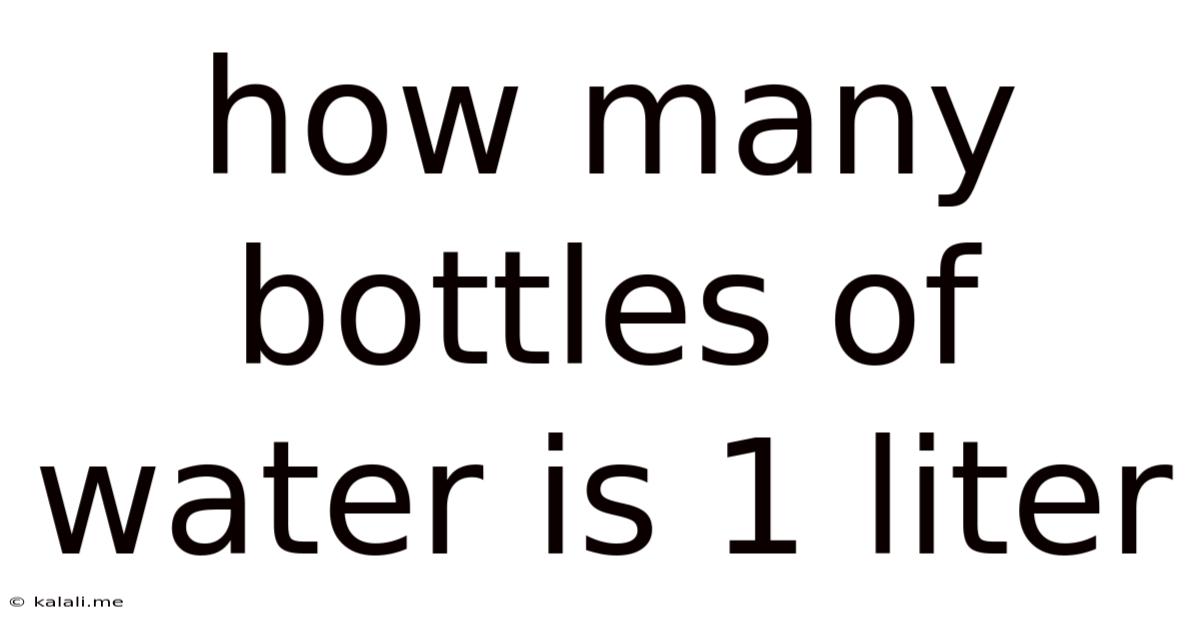How Many Bottles Of Water Is 1 Liter
Kalali
Jul 14, 2025 · 4 min read

Table of Contents
How Many Bottles of Water is 1 Liter? A Comprehensive Guide to Water Bottle Sizes and Conversions
Understanding liquid measurements can be surprisingly tricky, especially when dealing with everyday items like bottled water. Many people wonder, "How many bottles of water is 1 liter?" The answer isn't straightforward because bottled water comes in a wide variety of sizes. This comprehensive guide will delve into the complexities of water bottle sizes, provide clear conversions, and offer helpful tips for understanding liquid measurements. We'll cover everything from standard bottle sizes to the nuances of different brands and packaging.
Understanding Liters and Milliliters
Before we dive into the number of bottles, let's establish a firm understanding of the units involved. A liter (L) is a metric unit of volume, equivalent to 1000 milliliters (mL). Milliliters are a smaller unit, often used for smaller quantities of liquid. Understanding this fundamental relationship is crucial for accurate conversions.
Common Water Bottle Sizes and Their Liter Equivalents
The size of a water bottle varies considerably depending on the brand, intended use (e.g., single-serving vs. family-sized), and packaging. Here's a breakdown of common water bottle sizes and their conversions to liters:
-
330ml (milliliter) bottles: This is a common size for smaller, single-serving bottles. To find out how many make up a liter, we divide 1000mL (1 liter) by 330mL: Approximately 3 bottles.
-
500ml (milliliter) bottles: This is another popular size, often found in convenience stores and vending machines. Dividing 1000mL by 500mL, we find that 2 bottles equal 1 liter.
-
750ml (milliliter) bottles: These are larger bottles, often used for individual hydration throughout the day. A liter contains 1000mL, therefore, 1000mL / 750mL ≈ 1.33 bottles. This means a little more than one 750ml bottle makes up a liter.
-
1 Liter (1000ml) Bottles: This is the simplest case. One 1-liter bottle equals one liter.
Variations in Bottle Sizes and Their Implications
It's important to remember that these are common sizes. There's significant variation among brands. You might encounter bottles slightly larger or smaller than these standard sizes. For example, some brands might offer 400ml or 600ml bottles. Always check the label for the precise volume stated in milliliters or liters.
Furthermore, the shape of the bottle can also slightly affect the perceived volume. A taller, slimmer bottle might seem larger than a shorter, wider bottle of the same volume.
Converting Different Units: A Practical Guide
While we've focused on liters and milliliters, other units exist, like fluid ounces (fl oz), pints, quarts, and gallons. Being able to convert between these units is essential for comprehensive understanding. Here are some helpful conversion factors:
- 1 liter = 33.81 fluid ounces (fl oz)
- 1 liter = 2.11 pints
- 1 liter = 1.06 quarts
- 1 liter = 0.26 gallons
The Importance of Accurate Liquid Measurement in Daily Life
Understanding liquid measurements isn't just about bottled water; it has implications in various aspects of daily life:
- Cooking and Baking: Accurate measurements are crucial for successful recipes. Incorrect measurements can significantly alter the taste and texture of your dishes.
- Medication: Precise dosages are vital for medication. Misunderstanding liquid measurements can have serious health consequences.
- Gardening: Watering plants requires the right amount of water. Too much or too little can harm plant growth.
- Fuel Efficiency: Understanding fuel consumption, often measured in liters or gallons, is essential for budgeting and planning long journeys.
Beyond Water Bottles: Other Applications of Liquid Measurements
The principles of liquid measurement extend beyond simply determining how many bottles of water equal a liter. Understanding these units is critical across various fields:
- Scientific Experiments: Accurate measurements are essential for reliable results in scientific experiments.
- Industrial Processes: Manufacturing, chemical processing, and other industrial activities rely on precise measurement of liquids.
- Environmental Monitoring: Tracking water levels, pollution levels, and other environmental factors requires accurate liquid measurement.
Tips for Accurate Measurement
Here are some tips for ensuring accurate measurement of liquids:
- Use a measuring cup or graduated cylinder: These tools provide accurate measurements.
- Read the meniscus: The meniscus is the curved surface of a liquid in a container. Read the measurement at the bottom of the curve.
- Double-check your measurements: Always double-check your measurements to avoid errors.
Conclusion: A Holistic Understanding of Liquid Measurement
The seemingly simple question, "How many bottles of water is 1 liter?" opens up a broader discussion about liquid measurement, its importance, and its applications in our daily lives. While the answer depends on the size of the water bottle, understanding the relationship between liters and milliliters, as well as other units, is key to accurate calculations. By mastering these conversions, you'll be better equipped to handle various situations requiring precise liquid measurements, from cooking to scientific experiments and beyond. Remember to always check the label for the exact volume of your water bottle to ensure accurate calculations.
Latest Posts
Latest Posts
-
Food Preservation Does All Of The Following
Jul 14, 2025
-
How Did The Spanish Explorers Save Gas
Jul 14, 2025
-
How Much Sugar Is In A Jolly Rancher
Jul 14, 2025
-
How Many Units Are In 2 Ml
Jul 14, 2025
-
How Many Cm In A Square Metre
Jul 14, 2025
Related Post
Thank you for visiting our website which covers about How Many Bottles Of Water Is 1 Liter . We hope the information provided has been useful to you. Feel free to contact us if you have any questions or need further assistance. See you next time and don't miss to bookmark.